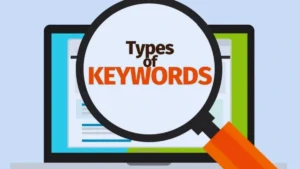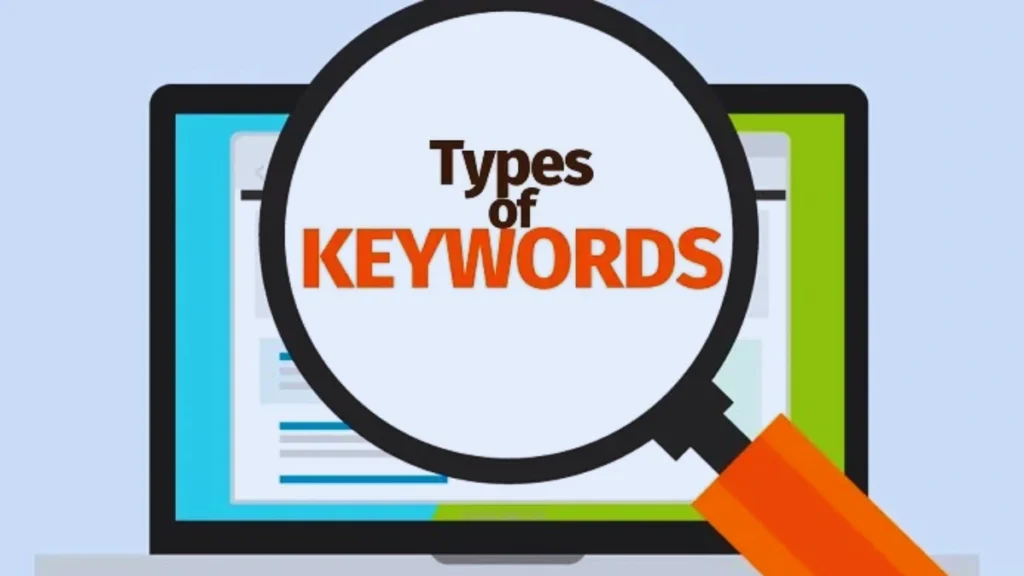Keywords play a pivotal role in SEO, guiding search engines to understand the content of your web pages and match them with relevant search queries. Understanding the different types of keywords is essential for crafting an effective SEO strategy. This article delves into the various types of keywords, their importance, and how to use them to enhance your SEO efforts.

|
Type of Keyword
|
Description | Example |
| Short-Tail Keywords | Broad, general terms with high search volume and competition. | “shoes” |
| Long-Tail Keywords | Specific, detailed phrases with lower search volume but higher intent. |
“best running shoes for flat feet”
|
| Branded Keywords | Keywords including a brand name, boosting brand recognition. |
“Nike running shoes”
|
| Non-Branded Keywords |
General terms without a brand reference, focusing on the product/service.
|
Types of Keywords in SEO: How to Use and Tools
How to Use Different Types of Keywords in SEO
- Short-Tail Keywords
- How to Use:
Short-tail keywords help increase overall visibility on search engines. However, they are highly competitive. To use effectively, target them in the homepage and category pages with high-quality, relevant content. - Best Practice: Use short-tail keywords strategically in titles, headers, and meta descriptions, but don’t overuse them.
- How to Use:
- Long-Tail Keywords
- How to Use:
Long-tail keywords are excellent for targeting specific user intent. They should be used in blog posts, product pages, FAQs, and other content aimed at solving a particular problem or need. - Best Practice: Incorporate them naturally into the content, making sure they align with the audience’s search intent.
- How to Use:
- Branded Keywords
- How to Use:
Branded keywords help with brand recognition and should be used on your homepage, about us page, and product pages. - Best Practice: Ensure your brand name is visible across your website and include branded keywords in metadata to enhance search visibility for your brand.
- How to Use:
- Non-Branded Keywords
- How to Use:
These keywords focus on the product or service without specifying a brand. Use them in blog content, educational resources, and landing pages that target generic searches. - Best Practice: Ensure your content provides valuable solutions related to the keyword to increase relevance and engagement.
- How to Use:
- Transactional Keywords
- How to Use:
These keywords indicate purchase intent and are crucial for e-commerce websites. Use them in product descriptions, checkout pages, and promotional landing pages. - Best Practice: Target them in call-to-action (CTA) buttons like “Buy Now” or “Order Today.”
- How to Use:
- Informational Keywords
- How to Use:
These keywords are used by people looking for information. Use them in blog posts, FAQs, and guides that provide value and answers. - Best Practice: Create long-form content that addresses common questions and offers insights on relevant topics.
- How to Use:
- Geo-Targeted Keywords
- How to Use:
Geo-targeted keywords are useful for local businesses. Use them on location-based landing pages, Google My Business listings, and local directories. - Best Practice: Include local landmarks or city names to attract customers within a specific geographic region.
- How to Use:
Tools for Keyword Research and Analysis
Here are some tools you can use to identify and track the effectiveness of different keyword types:
| Tool | Description | Link |
|---|---|---|
| Google Keyword Planner | Free tool to discover keyword ideas and search volumes. | Google Keyword Planner |
| SEMrush | Comprehensive SEO tool that helps with keyword research and tracking. | SEMrush |
| Ahrefs | Keyword analysis tool with an extensive database and competitive research features. | Ahrefs |
| Ubersuggest | Keyword suggestion tool offering insights into competition and trends. | Ubersuggest |
| Moz Keyword Explorer | Keyword research tool focusing on search volume, keyword difficulty, and CTR. | Moz |
Primary types of keywords
Keywords are the backbone of SEO strategies. They can be categorized based on their length, user intent, and other attributes. Knowing these categories helps in targeting the right audience and achieving better search engine rankings.
Short-Tail Keywords
Definition and Characteristics
Short-tail keywords, also known as head keywords, are usually one to two words long. They are broad and generic, attracting a high search volume.
Advantages and disadvantages
- Advantages: high search volume and potential traffic.
- Disadvantages: high competition and often less targeted.
Examples and Best Practices
Examples include “shoes” or “digital marketing.” To use them effectively, integrate short-tail keywords into your content naturally and complement them with long-tail keywords for specificity.
Long-Tail Keywords
Definition and Characteristics
Long-tail keywords are longer phrases, typically three or more words, that are more specific than short-tail keywords.
Advantages and disadvantages
- Advantages: lower competition, highly targeted, and higher conversion rates.
- Disadvantages: lower search volume.
Examples and Best Practices
Examples include “running shoes for women” or “best digital marketing strategies for small businesses.” Use long-tail keywords in your content to attract niche audiences and improve conversion rates.
Short-Term Fresh Keywords
Definition and Characteristics
Short-term fresh keywords are keywords related to trending topics or current events. They have a temporary spike in search volume.
Importance for Seasonal or Trending Content
These keywords are crucial for capitalizing on trending topics and seasonal events.
Examples and Best Practices
Examples include “Olympics 2024 results” or “Black Friday deals 2024.” Use these keywords to create timely content that attracts immediate attention.
Long-Term Evergreen Keywords
Definition and Characteristics
Long-term evergreen keywords are relevant for an extended period, often years.
Importance for Ongoing Relevance
These keywords ensure a steady flow of traffic over time, maintaining relevance.
Examples and Best Practices
Examples include “how to tie a tie” or “benefits of drinking water.” Focus on creating timeless content that remains useful and relevant.
Geo-Targeted Keywords
Definition and Characteristics
Geo-targeted keywords are specific to a location, such as a city, state, or country.
Importance for Local SEO
They are essential for businesses targeting local customers.
Examples and Best Practices
Examples include “best Italian restaurant in New York” or “SEO services in London.” Incorporate these keywords to enhance local visibility and attract nearby customers.
Intent-Based Keywords
Understanding User Intent
User intent keywords are classified based on what the user intends to do: gather information, navigate to a site, make a purchase, or compare products.
Types of intent-based keywords
- Informational: Used for searching information (e.g., “how to cook pasta”).
- Navigational: Used for finding a specific site (e.g., “Facebook login”).
- Transactional: Used for making a purchase (e.g., “buy iPhone 13”).
- Commercial: Used for comparing products (e.g., “best smartphones 2024”).
Examples and Best Practices
Use a mix of these keywords to cover different stages of the buyer’s journey, ensuring your content meets various user intents.
LSI (latent semantic indexing) Keywords
Definition and Importance
LSI keywords are terms and phrases related to your primary keyword. They help search engines understand the context of your content.
How They Support Primary Keywords
LSI keywords add depth and relevance to your content, making it more comprehensive.
Examples and Best Practices
For the primary keyword “digital marketing,” LSI keywords could be “online advertising,” “SEO,” or “social media marketing.” Integrate LSI keywords naturally to enhance content relevance.
Branded Keywords
Definition and Characteristics
Branded keywords include your company name, product names, or branded terms.
Importance for Brand Visibility and Recognition
They help increase brand awareness and capture traffic from users searching specifically for your brand.
Examples and Best Practices
Examples include “Nike shoes” or “HubSpot CRM.” Use branded keywords in your content and meta tags to strengthen brand presence.
Product Keywords
Definition and Characteristics
Product keywords relate specifically to the products or services you offer.
Importance for E-Commerce and Product Marketing
They are vital for attracting customers looking for specific products.
Examples and Best Practices
Examples include “Sony 4K TV” or “organic skincare products.” Optimize product pages with relevant product keywords to drive sales.
Competitor Keywords
Definition and Strategies for Identifying Competitor Keywords
Competitor keywords are the terms your competitors rank for. Analyzing these can help you identify gaps and opportunities.
Importance for Competitive Analysis
Understanding competitor keywords helps you devise strategies to outperform them.
Examples and Best Practices
Use tools like SEMrush or Ahrefs to identify competitor keywords. Incorporate these into your content strategy to capture some of their traffic.
Case Studies and Examples
Real-World Applications
For example, a company used long-tail keywords to improve its ranking for niche products, resulting in a 30% increase in organic traffic.
Success stories and insights
Another business leveraged geo-targeted keywords to dominate local search results, boosting foot traffic and sales.
Tools for Keyword Research
Recommended Tools
- Google Keyword Planner: For finding keyword ideas and search volume.
- SEMrush: For comprehensive keyword analysis and competitor research.
- Ahrefs: For detailed keyword research and backlink analysis.
How to Use These Tools Effectively
Use these tools to find relevant keywords, analyze competition, and track keyword performance.
Tips and Best Practices
General Tips for Effective Keyword Usage
- Focus on user intent.
- Use a mix of different types of keywords.
- Ensure keywords are relevant and naturally integrated into your content.
Common Mistakes to Avoid
- Keyword stuffing.
- Ignoring user intent.
- Failing to update and refine keyword strategies.
Strategies for Integrating Different Types of Keywords
Create content clusters around primary keywords and support them with related long-tail and LSI keywords.
Future Trends in Keyword Research
Emerging Trends and Technologies
AI and machine learning are revolutionizing keyword research, making it more precise and context-driven.
Predictions for the Future
Future keyword strategies will focus more on user intent and context, with a greater emphasis on voice search and natural language processing.
FAQs
- What are the main types of keywords in SEO?
The primary types of keywords include short-tail keywords, long-tail keywords, branded keywords, non-branded keywords, transactional keywords, informational keywords, geo-targeted keywords, and LSI (latent semantic indexing) keywords. - What is the difference between short-tail and long-tail keywords?
Short-tail keywords are broad, general search terms with high search volume but low specificity (e.g., “shoes”). Long-tail keywords are more specific phrases with lower search volume but higher conversion potential (e.g., “best running shoes for beginners”). - Why are long-tail keywords important for SEO?
Long-tail keywords help target niche audiences with specific search intent, leading to better engagement, higher conversion rates, and less competition compared to short-tail keywords. - What are transactional keywords, and why are they important?
Transactional keywords indicate purchase intent, such as “buy,” “discount,” or “best price.” They are crucial for driving sales and conversions, especially in e-commerce. - How can I find the best keywords for my website?
Use keyword research tools like Google Keyword Planner, SEMrush, Ahrefs, or Ubersuggest to identify keywords based on search volume, competition, and user intent. Analyze competitors and align keywords with your content strategy.

